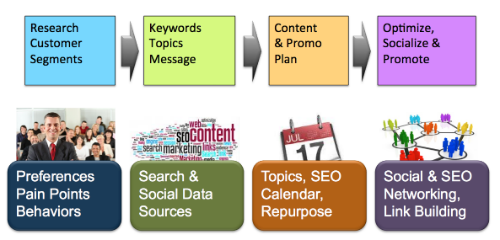 The pressure of competition and desire for business growth pushes marketers towards tactics that promise quick wins. Pundits advocate strategy first (been there) but doing so in a comprehensive way isn’t always practical, especially when it comes to areas like social media and content marketing.
The pressure of competition and desire for business growth pushes marketers towards tactics that promise quick wins. Pundits advocate strategy first (been there) but doing so in a comprehensive way isn’t always practical, especially when it comes to areas like social media and content marketing.
For marketers in need of practical advice on customer-centric, practical content marketing, a solid framework can be invaluable for an adaptive approach that is thoughtful about overall direction and measurable short term impact at the same time.
An increasing number of Search Engine Marketers are advocating both Content Marketing and Social Media in concert with achieving SEO objectives which is a great sign, but often lacking a customer-centric approach.
Here’s a Content Marketing framework that proves to be customer-centric as well as SEO and Social Media savvy that I think any smart online marketer can follow. Keep in mind, with a holistic approach, this 4 part framework can be applied to any type of online content that a company produces: HR, Customer Service, Public Relations, etc.

I talked about this approach at Content Marketing World recently and will be elaborating on it at several future events as well. Of course I drill down even deeper in “Optimize“. But since that book won’t be out until the first part of next year, here is a bit of an elaboration.
Customers – Optimize for keywords or optimize of customers? It may be semantics and it’s certainly not a mutually exclusive situation with customer segments and individual search keywords. Many online marketers focus on keywords that are popular and relevant to products and services without ever considering things like customer pain points, behaviors and position within the buying cycle and how that manifests as a search query.
Content Marketers organize their campaigns according to customer needs and how to influence those customers to buy. Add keyword optimization (SEO) to that mix and you have a very powerful combination.
- Identify customer segments – What do they care about? What is their context?
- Document pain points & information needs during buying cycle.
- Build a path of content including triggers that inspire purchase and social sharing.
Keywords – As you understand the language of your customer, the opportunity to optimize content for search “findability” becomes very important. What better place to connect with customers than at the moment they proactively seek a solution? Build relevant keywords according to customer interests into a content creation plan with key messages and you’ll be one step closer to “relevant ubiquity” .
Besides search keywords, it’s worth considering social topics. The interplay between searching and social referrals is becoming more standard as buyers navigate information resources online.
- Brainstorm and research keywords with tools like Google AdWords Keyword Tool, Wordtracker and Ubersuggest.
- Tap into social media monitoring tools to gauge what topics cluster together on social networks, blogs and Twitter, relevant to your search keywords.
- Organize search keywords and social topics into a keyword glossary shared with anyone in your company that creates online content.
“Content – is King and Creativity is Queen”, according to Pan Didner of Intel. I happen to agree. Content Marketing is growing and soon “everybody will be doing it” but certainly not doing it well. Through a combination of keen customer insight, analytics and smart creativity, online marketers can stand out amongst the 27 million pieces of content shared in the U.S. each day or the 5 Exabytes of information created every 2 days around the world.
Keywords and topics can fuel a Content Plan that provides a calendar of planned content publishing, topics, optimization focus, promotion channels and planned repurposing. Allow for wildcards and spontaneous content creation according to real-time opportunities and current events.
- Plan content according to customer segments, keyword topics and business services/product offering.
- Leverage search keywords for content optimization on the website, blog and on social media sites.
- Create modular content that can serve its purpose individually, as part of a matrix of topics and as repurposed content in the future.
Optimize & Socialize – Armed with customer insight, a keyword glossary and a content plan, it’s time for those Social SEO smarts to see some action. With content staff and social media teams trained on SEO best practices, new content will be easier for prospects and customers to find – when it matters. They’re looking for it! Monitoring search analytics for refinement of on-page optimization helps keep your investment in optimized search and social content high impact and current.
In today’s online marketing world, there is no “Optimize” without a smart dose of “Socialize”. Social network development and content promotion is essential to inspire sharing, traffic and links. Social links and web page links to your content provide a powerful combination for search engines to use when finding and ranking helpful information that leads your customers to buy and share.
- Train copywriting and social media staff on keyword glossaries and SEO best practices. Keep social topics up to date!
- Optimize web and social content on and off the corporate websites while engaging and growing social networks.
- Create, optimize and share useful content that will inspire customers to buy and share with their social friends.
The particular strategy, goals and methods of measurement will vary according to your situation of course, but as I mentioned above, this framework is applicable to any area of online content that a company might be publishing: Marketing, Sales, Customer Service, Human Resources, Public and Media Relations.
Have you seen examples of companies doing a great job of going from basic SEO to more robust content marketing optimization? Have you implemented or observed some great examples of “optimize and socialize”?


